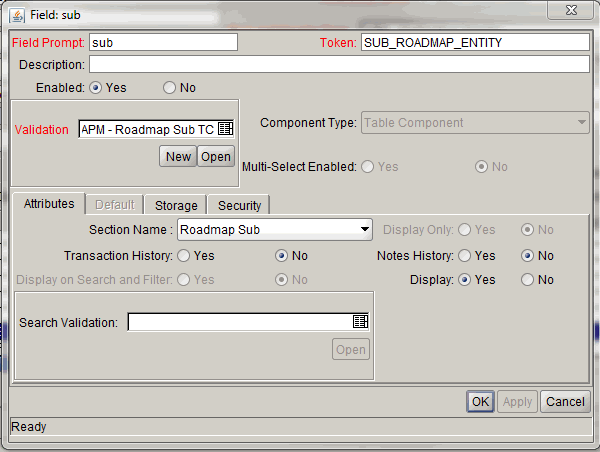Defining Roadmap Hierarchy in the Request Level
As an APM administrator, you can use one of the following two ways to define the roadmap hierarchy in the request level:
- (Recommended) Using Token SUB_ROADMAP_ENTITY to Define Roadmap Hierarchy
- Using APM_ROADMAP_ENTITY_HIERARCHY_V to Define Roadmap Hierarchy
(Recommended) Using Token SUB_ROADMAP_ENTITY to Define Roadmap Hierarchy
As an APM administrator, you can create a table component field using the token SUB_ROADMAP_ENTITY in a roadmap type, so that your users can enter child entities information in the table component field on the request detail page of the parent request.
For example, you can define a table component field in the roadmap type APM- Application, then your users can enter release or technology information on the entity detail page of the application.
The system fetches the child entities information from the table component field to generate the roadmap hierarchy in the Roadmap section of the request detail page, so that end users can view roadmap hierarchy from the request detail page of the parent request.
To create a table component field for a roadmap type using the token SUB_ROADMAP_ENTITY:
- Log on to PPM.
-
From the menu, select Open > Administration > Open Workbench.
The PPM Workbench opens.
-
From the shortcut bar, select Demand Mgmt > Request Types.
The Request Type Workbench window opens.
-
Click List and then select the desired entity request type that has been set as a roadmap type.
The Request Type window opens to the Fields tab.
-
Click New.
The Field: New window opens to the Attributes tab.

- In the Token field, type
SUB_ROADMAP_ENTITY. -
In the Validation field, select a table component type validation.
For the selected validation, make sure that the column that stores the entity IDs selects
PARAMETER1in the Parameter Col field.Note: You can decide which roadmap types can be added as sub-entities. If you do so, your end users can only enter request information of the specified roadmap types in the table component field. If you do not perform such configuration, your end users can add request information of any roadmap type in the field.
-
Provide values for the other fields as you desire.
For detailed instructions about creating fields for a request type, see the Creating Fields for Request Types section in the Demand Management Configuration Guide.
- Click Add or OK.
Using APM_ROADMAP_ENTITY_HIERARCHY_V to Define Roadmap Hierarchy
You can also define your own roadmap structure by using the database view APM_ROADMAP_ENTITY_HIERARCHY_V.
The following describes the definition of this view.
Foreign Keys
|
Primary Key Table |
Primary Key Column |
Foreign Key Column |
|---|---|---|
|
APM_ROADMAP_ENTITY_HIERARCHY_V |
ENTITY_ID |
PARENT_ID |
|
APM_ROADMAP_ENTITY_HIERARCHY_V |
ENTITY_TYPE |
PARENT_ENTITY_TYPE |
|
PFM_PORTFOLIOS |
PORTFOLIO_ID |
ENTITY_ID |
|
KCRT_REQUESTS |
REQUEST_ID |
ENTITY_ID |
|
KCRT_REQUEST_TYPES |
REFERENCE_CODE |
REQUEST_TYPE |
Column Descriptions
|
Column Name |
Null? |
Data Type |
Description |
|---|---|---|---|
|
ENTITY_ID |
NOT NULL |
VARCHAR |
Identifier for the entity. The value of this column should be either portfolio ID or request ID. |
|
ENTITY_TYPE |
NOT NULL |
VARCHAR |
Roadmap type of the entity. The value of this column should be either portfolio or request. |
|
REQUEST_TYPE |
NULL |
VARCHAR |
Entity type if the value of ENTITY_TYPE is request |
|
NAME |
NULL |
VARCHAR |
The name of the entity |
|
PARENT_ID |
NULL |
VARCHAR |
Identifier for the parent entity. |
|
PARENT_ENTITY_TYPE |
NULL |
VARCHAR |
Identifier for the entity type of the parent entity |











